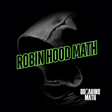The Role of Ratios in Science and Mathematics
00:00:00
Speaker
From MC squared's statement of mass-energy equivalence and Newton's theory of gravitation to the sex ratio of B's in the golden ratio, our world is characterized by the ratios which can be found within it. In nature as well as in mathematics, there are some quantities which equal in another.
00:00:16
Speaker
Every action has its equal and opposite reaction. Buoyancy is characterized by the displaced water being equal to the weight of that which has displaced it, and so on. These are characterized by a qualitative difference in what is on each side of the equality operator. That is to say, the action is equal but opposite, and the weight of water is being measured versus the weight of the buoyant object.
00:00:37
Speaker
However, there are some formulas in which the equality between two quantities is related by a constant. This is the essence of the ratio. So what can be measured with ratios? Why is this a topic of importance in science? And what can we learn from the mathematics of ratios?
Introduction to the Episode 'Rational'
00:00:52
Speaker
All this and more on this episode of Breaking Math. Episode 20, Rational.
00:01:05
Speaker
I'm Jonathan. And I'm Gabriel. And you're listening to Breaking Math. And today we're doing an episode on ratios. Yes. Ratios are all over the place in mathematics and in physics. This is a very exciting episode. Yeah. In a way all the ratio is, is it's so simple that the word comes up in the definition. It's a ratio between two quantities.
Common Examples of Ratios in Daily Life
00:01:25
Speaker
So obviously in this episode, we can expect to first talk a little bit about ratios, what they are and why they're important. Also, what are some of the important ratios that we'll be talking about?
00:01:34
Speaker
And we use ratios every day. Gasoline, for example, the price of gasoline is a ratio between how far you go and how much money you spend going that far. Yeah. Yeah. What are some of the ratios that we'll be talking about today?
00:01:47
Speaker
Today, what we're going to be talking about is, of course, the gravitational constant. We're going to talk about phi, the speed of light. In fact, all the physical constants we're going to be talking about, we're going to be talking about mathematical ones like pi and phi, which was already mentioned. And yeah, that's pretty much the gist of it. Yep. Alrighty, without further ado.
00:02:09
Speaker
So of course ratios are important just because there's no other way to relate two numbers through multiplication, you know. From my perspective, which is of course a 33 year old engineer who was also a teacher, I have certainly a profound appreciation for ratios. If you asked me when I was in seventh grade, I would have pretty much only thought of them as mathematics. But of course, almost all of physics, almost all of physics is of course ratios, that is physics equations.
00:02:38
Speaker
So, you know, that's that's everything from E equals MC squared. That is Newton's force equals mass times acceleration. Everything that is described as an equation, of course. Like the dielectric constant when you're doing capacitors or the springiness constant, elastic constant, that you could modify at will. So you have two different types of ratios, essentially. But the takeaway is that they're important.
00:03:01
Speaker
Yeah, in the case of all the constants, it's always one thing per something else. You know, it's always those units. Do you know right now offhand what the dielectric constant is in? I do not. Volts per something. I don't know. Puts you on the spot there. But the point is that a ratio, of course, is a description of a relationship. And that's very, very important when we are going to make sense of the world around us.
00:03:24
Speaker
So we're gonna give the example of E equals mc squared and show what that is. So you have on one side energy and the other side you have mass.
00:03:32
Speaker
Yeah, I just love it. I think I was in middle school when I actually considered the fact that you can have a description where you have mass times the speed of light squared and the fact that that is equal to energy as shown in this equation. The profoundness of that equation can't be understated. You know, Jonathan, I think that one of these days you ought to do a full podcast, in fact, on that equation or at least the math behind it. What do you think?
00:03:55
Speaker
Oh yeah, maybe it might be in the next episode. But also another one is gravity. So for gravity, and this is something that actually guest Zach brought up on the language of the universe. When you do gravity, you multiply the masses and you divide by the square of the distance between them. But that's not all you do. You have to have a constant. In this case, a gravitational constant.
00:04:19
Speaker
And the gravitational constant is in really weird units. I remember trying to make sense of them and it's very difficult to do. This reminds me of another idea I once had. I wanted to do a whole episode on just our favorite equations. And that's one of them. The other one of my favorites that I'd like to talk about is Stephen Hawking's information paradox. It also has the gravitational constant in it. That's quite a profound equation as well. Oh, yeah, definitely.
The Fascination with Phi in Nature and Art
00:04:44
Speaker
Perhaps one of the most famous ratios is known by the name phi and is related to the Fibonacci sequence, which is found all over nature. Simply put, phi is a number such that the ratio between phi and 1 is equal to the ratio between 1 and 1 over phi. Intuitively what this means is that when you multiply phi by itself, you get 1 plus phi. Multiply that by phi and you get twice phi plus 1. Any round power of phi can be made by multiplying phi by a whole number and adding another whole number.
00:05:12
Speaker
is being renounced as antiquity for its aesthetic and mathematical properties. Where can we find phi, for example, in the human body? Ooh, ooh, there's a lot of places actually. Take a look at your arm. You'll notice that your forearm is a little less than half of the length of your entire arm. If you were to measure this, usually you'd see that the ratio between the part of your arm that is not your forearm and the forearm is actually pretty close to phi, in fact.
00:05:38
Speaker
The golden ratio, golden spiral, all these things, you've probably seen them online, and really a lot of that is unfortunately pseudoscience. For example, the Parthenon, if they measured phi, it was not very carefully, and Greeks are nothing but careful when it comes to math. Yeah, and actually, when I was younger, I also learned that the Parthenon is actually equal to phi. Now, the truth is that it's not in fact equal.
00:06:00
Speaker
It's only within like one decimal point or something like that, one or two. Is that a mistake that we can forgive the Greeks for or should they have known better by then? Well, I mean, they had advanced enough engineering to make big old pillars and things like that. They knew how to measure. I see. Okay. And they could have constructed it using a straight edge, which is something they would have done.
00:06:20
Speaker
Interesting, interesting. Yeah, then I wonder how that got pulled off. Maybe they thought nobody would notice. I think the answer is it just happens to look aesthetic. The ratio fee is very pleasing to us. So we tend to approximate it, but it's not like an exact science. Now we talked earlier about the forearm. This was first introduced to me when I took an art class. I think it was in high school. I'm always alluding back to school. I can't help it. That was a very meaningful time from my first introduction to math and science. So I'll probably keep doing that.
00:06:48
Speaker
We were learning about Renaissance art, and I think it was Leonardo da Vinci and his Vitruvius man. And I think that one of the reasons why his art, as well as the sculptures of ancient Greece, were so realistic looking and so beautiful was that they oftentimes used the approximations that are related to phi when creating the arms and the fingers and things like that. Even with the fingers, I believe, the digits of your fingers, they also get smaller according to phi.
00:07:14
Speaker
Oh yeah, and one thing you did mention was a Vitruvian man. A common misconception about the Vitruvian man is that it was made to illustrate phi. It was made to illustrate squaring the circle. He thought that he found a way to do it using the human body. Okay, okay. But it does have phi embedded within it, and that's what makes phi so confusing. You never know if it's there or not, unless you have really accurate measurement.
00:07:35
Speaker
It's fascinating how that just pops up all over the place in Renaissance art. I've also, you know, I've seen a lot of people who will put a Fibonacci spiral in art, and sometimes I think they just kind of stick it on there, whether it's there or not. Oh yeah, I've seen it in ridiculous places. I've seen pictures of, I think in a courtroom, there was a big argument happening and people were fighting, and somebody decided to just draw a Fibonacci circle over everyone's head, and somehow it touched everyone's head or something, but that's... Yeah, it's silly. Yeah, it is, it is.
00:08:05
Speaker
And we're gonna talk really quick about the Fibonacci sequence. So With the Fibonacci sequence you start with two ones, right? Yes. Yes, actually is it fair to say that you start with zero or Depends on where you start counting because you could do with the Fibonacci sequence backwards, too But we won't explain that but we'll explain how to do it forwards
00:08:25
Speaker
I love the Fibonacci sequence, and I think that to really capture the beauty and the relevance, perhaps some of the videos available online might be necessary, or rather not necessary, but suggested, of course. Oh yeah, absolutely. Just Google Fibonacci sequence in nature. So you start with one, and the basic pattern is basically you add the previous amount. Yeah, so you have one and one, and then one plus one is two. So you take the first one, throw it away, and you're left with one and two. One plus two is? Three.
00:08:54
Speaker
2 plus 3 is 5 3 plus 5 is 8 8 plus 5 is 13 and so on and that's yeah and what's cool about that is that let's say we have a really high Fibonacci number like I think 144 is a higher one and you divide that by 88 or whatever the previous one is you'll get closer and closer to fee
00:09:15
Speaker
And that's the higher up you are in the Fibonacci sequence. Yeah, for those of you who are in calculus, if you have f of n being the nth Fibonacci number, then limit n approaches infinity of f of n plus 1 over f of n equals phi. I'm sure you all caught exactly that, right? Did you all catch that? I hear crickets.
00:09:36
Speaker
That's another fascinating number. Also limits,
The Unexpected Beauty of Pi
00:09:39
Speaker
those are also quite a concept. I have a hard time when I imagine infinity or try to think of infinity, so the fact that we use it all the time in limits is trippy. In ancient Babylon, there's a number very important to engineering. This number was three and one eighth. This number was about half a percent away from being correct.
00:09:57
Speaker
has been ingrained in the heads of high school students as a noble constant pi. The Greek symbol is used to represent a ratio between a circle's circumference and diameter, but it shows up in places where no one would reasonably expect it. For example, if you take the constant e, which deserves its own episode, and raise it to the power i times pi, you get negative 1. So that's one of the weirdest places it shows up.
00:10:21
Speaker
That is oftentimes considered one of the most beautiful equations. I've seen that written about many, many times. And that's Euler who discovered that, right? I believe so. Leonard Euler. Fun fact, my PlayStation Network sign-in name is Leo Euler 2718, named after the famous mathematician himself. You're going to get some people joining you on PlayStation. That's fine. That's fine. I haven't had a whole lot of time to play recently, but that's totally fine. You can say that you heard about me here.
00:10:50
Speaker
So one cool thing about pi, okay, should we introduce the concept of hypersphere? Hypersphere, you know, just that name itself sounds pretty awesome. I think we should.
00:10:59
Speaker
All right, so what's a two dimensional sphere? So a two dimensional sphere is like a slice of a sphere. It's just a circle. What's cool about that is that you start with a point and every other point that is less than a certain distance away from it is included within that circle. So if a point is half a foot away from the thing and the circle has a radius of one foot, then it'll be in the circle. Otherwise it's not. So that's how you could define a sphere. So a three sphere is just the same thing, but in three dimensions.
00:11:28
Speaker
I'm gonna say what you said, but in maybe a slightly different phrasing. When you asked me what's a 2D sphere, and then I had mentioned what is a slice of a sphere, it depends on where you take that slice. If you take it at the very, very end of it, it is just a single point. But if you move any length whatsoever from that point toward the center of the sphere, for instance, or the opposite end of the sphere, then you have an actual circle.
00:11:51
Speaker
the end of a sphere would just be um a point in this case would just be a circle with radius zero okay because just the definition of a sphere or a ball i can't remember which number you use for which has to do specifically with what's called the neighborhood in the space that it's in so basically the collection of all points happen to be less than a certain distance away from it
00:12:12
Speaker
You know what? I actually love that because right now you actually put what might seem like an arbitrary distinction, but it's meaningful. I said it was just a point and you said, well, no, technically it's a circle of radius zero, which I would think of certainly as a point, but the distinction is important. It's ontologically weird for sure, but yeah. It's all about zero. There's a great book by the author is Charles Sheaf, I believe it's called the biography of a dangerous idea.
00:12:39
Speaker
Oh yeah, it is a good book. Alright, so quick geometry lesson. If I have a gingerbread man, and I know that his smile is one unit across, and I know that the gingerbread man uses a certain amount of dough, and we're assuming that this gingerbread is infinitely flat,
00:12:58
Speaker
then if I had another gingerbread man identical to it, but the distance between the smile was two units, it would have four times the area as the previous gingerbread man, because you take a measure and then you raise it to the second power. Same thing with the volume. So if you made the cookie thicker as well, it would have eight times the dough. Am I making sense, Gabriel? I am sort of following, but I'm also getting really hungry too. So maybe we can do a quick recap of that.
00:13:26
Speaker
Sure. So let's say I have a weird shape and I know that it has a certain area. Should we just say a shape of like a teardrop or a shoe even? Cause a shoe. Okay. Sure. A shoe. If you have a cutout of a shoe and if you have a cutout that is twice as long in every dimension, then you use four times the amount of paper. Okay. Yes. Yes. I am following. But let's say we have a sculpture. If I make it twice as long in all three dimensions this time, it'll have eight times the volume. Yes. Yes. Okay. I get it. So this is a matter of dimensions versus volume.
00:13:56
Speaker
Yeah, and so we know that for a circle, there must be a certain constant relating the radius to the circumference, and it happens to be pi. Okay. I mean not the radius to the circumference, the radius to the area, which is also the radius to the circumference, and that happens to be pi. So you might think that for a sphere, it would have to be something else, some other constant, because they're related, but nobody knows how related they are until our communities of Syracuse.
00:14:20
Speaker
who deserves his own episode. Oh, he does. That's gonna be a whole thing just saying so
Exploring Higher Dimensions with Hyperspheres
00:14:24
Speaker
-and-so deserves their own episode, but it's true. They absolutely do. And the fact that we keep seeing these repeated themes everywhere. Oh, everything deserves its own episode. It's like the Oprah Winfrey of mathematics. You get your own episode. Okay, I'm gonna stop.
00:14:36
Speaker
Yeah, four-thirds pi r cubed is the formula for the volume of a sphere. A six-dimensional sphere is equal to one-sixth of pi cubed times the radius squared three times. So it gets a little bit complicated, but it's still pi cubed. So for example, the volume of a six-dimensional sphere is equal to one-sixth of pi times the radius to the sixth power.
00:14:59
Speaker
Real quickly, I just want to slow down just a bit, because I think the idea of hyperspheres is awesome. Of course, you may recognize the hypershape hypercubes from a previous episode, actually our very first minisode. I think it was called Hypercubes and Other Stranger Things. But with hyperspheres, real quickly, is there a way that we can visualize just going from a three-dimensional hypersphere to a four-dimensional hypersphere, and those are all four spatial dimensions, just so that we can have a stepping stone up to six?
00:15:28
Speaker
Sure, there's actually a good example. If you've ever blown up a balloon, you see how it kind of goes big at first and then it gets bigger more slowly. So if you imagine blowing up a balloon and then letting the air out of it, that's what a hypersphere traveling through time would look like.
00:15:46
Speaker
Yeah. Interesting. Interesting. So is that sort of like, you know, if you had a line, a single line in two dimensions and you had a circle pass through it, that line would experience the point of the circle and then it would experience the circle itself and then it would leave it. Yeah. It's, it's also the same example that you had earlier, actually. Um, when you, because when you cut a three dimensional sphere, you get a two dimensional sphere. So when you cut a four dimensional sphere, you get a three dimensional sphere. If you cut it with three dimensions.
00:16:13
Speaker
That's the only way, that's literally the only way that I can even begin to fathom hyper shapes is I have to imagine what I'd experience if a shape of a higher dimension pass through the third dimension in time.
00:16:26
Speaker
Oh yeah, for sure. And for more on hyperspheres, we might be coming out with an applet soon, in addition to the hypercube applets. Not only an applet, but I think that very soon we should have a whole series of posters and maybe some wallpaper and stuff that has not only hyper shapes, but also the equations that go with them. Look out for that. And we talked about Gabriel's trumpet on another episode, but that's when you revolve a certain graph around the center, the graph of one over X and take the volume from one to infinity, you get pi.
00:16:56
Speaker
Yeah, I've said this before, ratios essentially is, I mean, what does it not pertain to? I think you even have on the Facebook page, you did some mathematics, some art inspired by math, and you used a program on your Mac. Isn't that right? Using just grapher and just ratios with, I think it was sign functions and, you know, a couple of things. Oh yeah. We have that up on our Facebook page at facebook.com. It's pretty cool.
00:17:21
Speaker
And it comes up in weird places like we said before, like the Mandelbrot factor near negative three quarters and then just almost just a tiniest little bit away from zero, you get pi in a complicated way that we can't go into.
00:17:35
Speaker
You know what, what's kind of interesting is I'm not a mathematician. I always thought I'd consider myself one, although I'm a great appreciator of mathematics. When people discover pi in those places, it makes me wonder what else you can infer about mathematics knowing that pi is there. So in other words, what other properties of circles and spheres and in the mathematics of spheres also show up in the Mandelbrot set.
00:17:57
Speaker
You know what I mean? Oh yeah, it might be related and might not and that's definitely a good field of research though. Yeah, absolutely. Humans are a little bit obsessed with the accuracy of Pi and let me tell you exactly how obsessed we are. If we had 100 digits of Pi, just 100 digits, would you can memorize in an afternoon?
00:18:18
Speaker
Imagine, if you will, the earth being the size of a grain of sand. The sun would fit in your hand and be about 30 feet or 11 meters away. Pluto's orbit would be about half a kilometer or a quarter mile away from the sun. Walking his orbit at a steady pace would take you 620 centuries, going back to the actual solar system,
00:18:36
Speaker
and takes Pluto itself 248 years. So we're talking a vast distance, right? These are things going kilometers per second and things like that. So to measure this orbit to an accuracy of one trillionth of the width of the finest human hair will only require, if Pluto's orbit were entirely circular, 30 digits of pi. Oh my gosh, wow. Wow. So there's no reason to keep calculating digits, but it's fun. Yeah, interesting. Wow. When you say things like that, I think that I'll never get bored as long as I've got mathematics, right?
00:19:08
Speaker
Onto the records. Babylonians had one decimal point of accuracy three millennia ago. And then Archimedes, we talked about him before, got three digits from the circumscription and inscription of a 96 gun around 250 BC. That's the termination right there. He basically just, you know, I think he started with a triangle. Was it a triangle or a square? He just kept adding angles.
00:19:43
Speaker
You know what's interesting? Quick side tangent. Suddenly hearing how Archimedes did this or discussing it, I kind of want to make a computer program that does that same approximation.
00:19:52
Speaker
And this raises the question, why on earth would I want to make a computer program that finds pi through the method of exhaustion? Well, my answer is why the heck not? I don't know. I just, I think it would be fascinating to do. You know what I mean? Like that's just. Oh yeah. It's not very fast though. There's much faster algorithms. Yeah. So yeah, let's just run through these. Uh, next one. Oh yeah. Sure thing. So this is interesting. Uh, Leo Hui got five, he got five decimals in, um, two 63 AD.
00:20:21
Speaker
So Madhava of Sangamagrama got 10 in 1400. And then Snellius got 38 in 1621. Do you suppose he got made fun of as a kid for his name? Oh, that was his Latin name. His real name was something like Snell. Okay. Which is not better. So then John Wrench and L.R. Smith got 2037 on the ENYAG in 1949. And let me just point this out. The ENYAG is insanely difficult to program and writing this kind of program would be really difficult. So hats off.
00:20:49
Speaker
Wow. So, wow. Okay. Okay. Then we have a gentleman by the name of Francois. Um, I mean, I'm going to say this correctly. Um, can we, I have no idea. Yeah, I'm so sorry. Okay. Wow. I haven't even counted how high this is. So, uh, is it 22 trillion, 459 billion, 157 million, 718,361 digits is the current record of PI.
00:21:13
Speaker
And remember, 30 digits is enough to do the whole human hair in Pluto's orbit thing.
Partnership with Brilliant.org on Ratios
00:21:20
Speaker
This episode is all about ratios and their importance in math and physics. To that end, our partner Billion.org has a chapter in the Algebra Through Puzzles course about rate and ratios, which helps you learn about proportionality and apply them to solving circuits. I love the problem in advanced circuits about infinitely many resistors in series in parallel. I was excited to see the golden ratio appear.
00:21:39
Speaker
actively working through these probabilities and valuable exercises that you don't usually get. To support your educational journey in math, go to brilliant.org-breakingmath and sign up for free. The first 200 breaking math listeners get 20% off the annual subscription, which you've been using. And now, back to the show. As has been previously stated, there are ratios to be found in the natural world.
Understanding Universal Constants
00:22:03
Speaker
The ones that we'll be discussing in particular are known as universal constants.
00:22:07
Speaker
Universal constants are fascinating. These are a very, very important thing to talk about when trying to get an understanding of physics and the universe that we live in. How would you describe the importance of universal constants? Would you say they're kind of like the main controls in our universe? To me, they're kind of like when you're making a smoothie, you put in some strawberries, but then if you put in too many strawberries, it gets icy. Frozen strawberries. If you put in too much kefir, it gets gloppy.
00:22:37
Speaker
So getting the ratios right, I'm doing a lot of food things I must have not eaten, but it's basically the way that things stick together in the universe. Gravitational constant, plane's constant, all these have to do with not only how things stick together, but how much more important certain types of thing are. I like that. You know, one other way of looking at this are these are things in the universe that do not change. Hence the name constant.
00:23:03
Speaker
And we measure them all the time. Yeah. What actually really fascinates me while I'm looking at these constants that we're about to name here in a few is a belief by a 20th century physicist by the name of, I believe it was Enrico Fermi. Is he the one who believed firmly that there was a profoundly deep relationship between the universe itself and the entire field of mathematics?
00:23:29
Speaker
Oh, yeah, I think you're skipping ahead a little bit. I think he's the one that believed that 137 was the exact inverse of the Find structure constant. Okay. Well, yeah, I don't want to get too ahead of myself, but it certainly illustrates the awesome relationship between mathematics and physics
00:23:45
Speaker
So first we're going to talk about the gravitational constant. And that's equal to 6.67 times 10 to the negative 11 meters cubed per kilogram per second per second. So it's a stupid unit. It's bizarre. It's only used to justify the formula. Indeed. You multiply it by a planet's mass and divide it by the radius between wherever you want to find the strength of the field. And that gives you the surface gravity. Well, you have to divide it twice. So by the radius squared. Thank you. I'm so sorry. I stand corrected. That is correct.
00:24:16
Speaker
And so that's an extension of the formula. If you take the mass of the earth and divide by the radius of the earth, you get the surface gravity of the earth, which is kind of cool. Yeah. And again, let's say who was, who was the first physicist? I'm sure this was a pretty famous one. Not one of your favorite guys. Who was the one who first penned this down? I don't remember his name, but he was Arabic, the first guy to discover the universal gravitational thing. He was rediscovered by a guy named Newton.
00:24:42
Speaker
Yeah, rediscovered, not the original one. And regarding the gravitational constant, who was it that introduced it?
00:24:51
Speaker
Well, the gravitational constant was not known until way after that they started using it, actually, because nobody knew the density of the Earth, but Newton used a formula that required it. Okay. I think it was about a hundred years, actually, before it was measured. Interesting. Basically, he was trying to describe the speed of the acceleration of something falling and he just, he needed it.
00:25:14
Speaker
more like the attraction between two objects, the universal theory of gravitation, which that's the one that requires a gravitational constant. And so this one guy built a shed and he had like a dumbbell type thing hanging from a thread and he looked at it with a telescope and he looked at how much it twisted when two weights were placed next to it. My goodness. That, that precision is just remarkable. And when was this?
00:25:42
Speaker
like the 1700s. And what's even more insane about that is there is a bunch of surveyors that were measuring a mountain because they noticed that there's different gravity on the top and the bottom of the mountain. So if they knew the exact volume of the mountain, they could calculate the gravitational constant and they're less accurate. Oh my goodness. This is, oh, this is just insane. It's one of my favorite experiments because it's pure.
00:26:03
Speaker
Yeah. Yeah. Now I'm sorry. Are you referring to the mountain one? No, no. That one's very busy. Okay. Okay. Wow. Just to think that somebody would even think to, to look at a thread with a telescope. Oh my goodness. And this is again, forgive my quick tangent, but this is relevant. When I think about the shape of a bell, I think it's relevant because, uh, he didn't choose that shape arbitrarily. There's a reason why he chose it, right? Is it the weight distribution?
00:26:30
Speaker
Well, it wasn't a bell. It was like a dumbbell type shape. So they had two masses apart from each other. Sure. I suppose that any shape that would have worked as long as it was, um, it was important that the center was close to as massless as possible. And he basically had two weights opposing one another twisting. I see. I see. Wow. That's fascinating. Then we get what's the next constant. This next constant is, um, quite, quite a game changer here. It's planks constant.
00:26:58
Speaker
So it's equal to 6.63 times 10 to the negative 34th joule seconds. And to tell you how little this is, there's a thing called action in physics, which is basically measuring things that are moved. It's hard to explain. It has to do with functors. I'm sorry, what are functors?
00:27:15
Speaker
Things that map functions onto numbers. So in goes a function, out goes a number. Okay. And this is one tenth of one millionth of one billionth of one billionth of one billionth of the action of a baby crawling for a second. Wow. That is tiny. Yeah, it's like nothing.
00:27:34
Speaker
Now, Planck's constant is interesting because this particular constant was arrived at by just an act of desperation from the physicist Max Planck.
Planck's Constant and the Ultraviolet Catastrophe
00:27:44
Speaker
Do you remember why he came up with this number?
00:27:47
Speaker
It was just to explain the data that he was kind of got fit the formula to empirically. Wasn't that correct? Yeah. Well, so he was tasked with something. He was tasked with trying to find a way of describing, I think it was Luminosity from a German light bulb company. They didn't have a standard way of describing it. And while he was trying to do it, he ran into something called the ultraviolet catastrophe.
00:28:12
Speaker
I don't know if you recall from the physics. Oh yeah, for sure. Yeah. So the ultraviolet catastrophe is using the only way that they had, that he had at a time of describing, uh, how bright something is. The higher the frequency, the higher the energy, uh, went just until it went to, was it an infinity? Yeah. Infinity for certain. So basically it described an impossible situation. Yeah. And wherever you find infinities and zeros, you discover things.
00:28:39
Speaker
We're going to have to actually talk about the equation itself, but essentially when he inserts this Planck's constant, which is such a small, small number, it changes it, but it has drastic consequences in the world of physics.
00:28:54
Speaker
It's principally to measure the energy of a thing of light. So you just multiply it by the frequency to get the energy. This is describing the frequency. And frequency is really discovered through Planck's constant of light and things like that. I don't think it was actually discovered through it, but it was related to that. I want to talk about Feynman. Didn't Feynman have an example of energy and how it's measured philosophically?
00:29:16
Speaker
Oh yeah, so he gave the example of having blocks in a room. So you have like 20 blocks in a room, and then one day you go in there and you see 16, but then you see 4 on top of the bed, and the next day you only see 12, but then you see the chest of drawers closed, so then you assume that there must be a certain amount in the chest of drawers, and that assumption never leads you wrong. So empirically we know that energy is never lost or destroyed, and I thought that was just an interesting anecdote.
00:29:40
Speaker
Oh, okay. Okay. I like it. I like it. Oh, wasn't there an analogy about smoke, like, um, smoke being smoke blown off a cigarette is white. Oh yeah. The classic example, smoke is a white one is exhaled with blue when it's not because of the wavelength of light and the size of the smoke particles. The smoke particles are so small that the red light skips them or is diffracted and you see the blue light or vice versa and, um, white because then it's just evenly spread.
00:30:10
Speaker
Yeah. And speaking of that, you know, with respect to frequency and wavelength, wavelength can be anywhere from multiple kilometers all the way down to less than 10 picometers.
Measuring the Speed of Light Historically
00:30:20
Speaker
Next constant here is the speed of light. Yeah. And that's three times 10 to the eighth meters per second. So it's very, obviously very fast. So many things would be different if we lived in a world with a small speed of light. There'd just be less energy for equivalent mass. So the balance of mass and energy in the universe would be completely thrown off.
00:30:37
Speaker
And didn't ol' Romer first showed that it was measurable by studying Jupiter's moon Io? Oh yeah, he measured it using the shadows and the exact times that you could see the moons. It was crazy. It was like in the 1700s or 1600s.
00:30:52
Speaker
Now, I actually want to talk a little bit about the speed of light and I'm gonna talk about a rotating mirror experiment. There was a gentleman by the name of Physio. All right, here goes a whole mouthful. This is gonna be like a Texas steak challenge of a podcast. We got a lot of information that's about to come out yet. So this is Physio's Rotating Mirror Experiment. You want to take this one?
00:31:13
Speaker
Sure, so you take a beam of light and you send it to a mirror which reflects it right back, so it's just bouncing right back and forth, right? So you observe this using an eyepiece resting above a semi-transparent mirror, so that's a mirror that lets half the light through and half the light not through. It actually splits up the photons, angle of 45 degrees, so it reflects the beam at a right angle relative to the beam. So then you put a gear halfway between the light source and the first mirror.
00:31:41
Speaker
And they're really far apart, so we're talking kilometers. So when light leaves the source, it passes through the gap between the gear's teeth. And then the gear is rotating, by the way. So it's really quickly, like 720 things per second. And it has tons of teeth.
00:31:58
Speaker
So, the packet of light goes back to the IPs in the source, the gear has turned such that half of the light is eclipsed by a tooth on the gear. So basically, it's going all the way through the first time, and only half of the way through the second time, and then we observe that using our human eyes. Focault actually improved on Fizzo's technique by making the mirror itself rotate and measuring the deflection of the beam. So you could actually measure the speed of light as the takeaway, I guess.
00:32:23
Speaker
Oh wow, yeah, that was quite a mouthful. Okay, there's lots that we can talk about with this constant. Squaring and multiplying by mass gives the energy inherent to that mass, which was... Yeah, e equals n c squared, basically.
00:32:39
Speaker
And of course dividing by frequency gives the wavelength, which is an intrinsic property of any object, but most intuitively particles and photons. Yeah, so I can't remember what the name of this wavelength is, but everything has it. Yeah, fun fact, even matter has a wavelength as well.
00:32:55
Speaker
I think that it comes into play practically in mass spectrometry, which if you ever have taken a drug test, a really expensive drug test, you've encountered. Is it really mass spectrometry on those? I had no idea. I assumed it was just straight up chemical. Well, half the time they use enzymes, but they're doing a police test. They use max spectrometry. Oh, okay. Interesting. Okay. I was thinking that that was related to the electrons and not to the actual matter itself. I'm actually talking about neutrons. Neutrons themselves have a wavelength.
00:33:25
Speaker
Oh yeah, I'm talking about the wavelength of the actual molecules because max spectrometry, what that is, you pulverize a thing and you weigh the individual things that come off of it, individual atoms. Yeah, in fact, and then again, the part that I was getting at that was just nuts was I think, I believe it was the French physicist born actually.
00:33:47
Speaker
He was the one who said, okay, okay, so if light has a wave particle duality, then certainly particles have a wave particle duality too. And he was correct. You know, it's a pretty wild idea, but it's true. Yeah. And so we're going to move on now to the elementary charge. And what's that equal to? That is equal to 1.602 and then some times 10 to the negative 19th coulombs.
00:34:10
Speaker
So that's a fraction of one millionth of one millionth of the charge that you get from combing your hair. Now I want to point something out about these. Some constants are large, like the speed of light. I actually think it might be the only large constant compared to the other ones. And the other ones are very, very tiny. Yeah, they're absolutely small. This is a quick side note. Do you remember how elementary charge was discovered?
00:34:34
Speaker
Yeah, it was the Milgram oil drop experiment. Milliken, is that his name? And there's a little bit of controversy about that, both in terms of if it really was Milliken or some, say, his lab assistant. Now, again, this is a bit of a side note, but I think there's a little bit of controversy as to whether it really was Milliken or perhaps his lab assistant. Perhaps we won't get into that now. But also, was his measurement value accurate or has it been modified since? Oh, it was pretty accurate. It was a little bit low.
00:35:03
Speaker
And Feynman pointed this out. The experiment subsequent, it kept getting higher and higher, but it approached a tangent line basically. And as Feynman pointed out, we have modern ways of dealing with that kind of bias that we use all the time. And basically what he did is he had charged particles on oil drops and he designed them to drop. And I think what he did is he measured. He switched the thing on and off and then he had to suspend a drop of oil next to a microscope. It was difficult.
00:35:32
Speaker
Yeah. Yeah. And it's one of the most physically meaningful universal constants, but it might not be the fundamental as we will see in a sec. What we mean by physically meaningful universal constant is the smallest charge that a particle can have.
Boltzmann's Constant and Kinetic Energy
00:35:47
Speaker
And then the next one we're going to talk about is the Boltzmann constant. Boltzmann's constant equals 1.38 times 10 to the negative 23rd joules per degree in Kelvin.
00:35:58
Speaker
joules per kelvin and it's the same units as entropy or disorder. It's used to measure kinetic energy of particles and gas. So half of the Boltzmann constant times the temperature of the gas equals the average kinetic energy of particles in that gas. All right, so then this next one is part of your job, vacuum permittivity. Indeed, vacuum permittivity is 8.85 times 10 to the negative 12 ferroids per meter.
00:36:22
Speaker
All right, and there's a thing called Coulomb's law, right? And can you describe that and how it relates to gravitation? Yeah, yeah, actually, so Coulomb's law looks a lot like Newton's inverse square law of gravity, except for this one applies to two charges. This is the product of two charges over the product of four pi times the vacuum permittivity constant and the distance between those, the charges gives the force between the charges.
00:36:50
Speaker
So this is another force constant and that's why it looks a lot like the previous one because gravity is a force and so is a coulomb of charge. Yeah, it's basically the only difference between gravity and this is that like charges repel each other. There's no repelling in gravity. That's correct. And there's a very important distinction for reasons that we can't go into.
00:37:12
Speaker
So natural units, we said all these things are equal to whatever point, whatever times 10 to the whatever, right? Yeah, pretty much. But then if you set the gravitational constant, the reduced Planck constant, the speed of light, and the Boltzmann constant, and the Coulomb constant even,
00:37:29
Speaker
the vacuum permittivity constant and set them all equal to one, then the elementary charge is equal to the square root of this number called alpha, and the electron rest mass is the square root of alpha G. So these two mysterious numbers, alpha and alpha G, show up. And what's the philosophical relevance do you think of that?
00:37:46
Speaker
Okay, so the same in every system of units. That is to say, every natural unit system has this constant and another constant called the gravitational coupling constant, which essentially is equal to 1.75 times 10 to the negative 45th.
00:38:03
Speaker
And Alpha itself is equal to about one over 137. And this is what, I think it was a physicist you mentioned earlier, thought that this was an intrinsic property of the universe. That it was exactly, it might have been him, that he thought it was equal to exactly 137. Now we know for better measurement that it's 137.0 something and he crushed his dreams. Oh I know, forgot. Now it was either an integral for me or perhaps it was Pauli. And I'm not sure I remember which one it was right now.
00:38:33
Speaker
However, yeah, this pair of constants describes the ratios between the constants, which themselves measure ratios. So it's like inception. It's like ratios of ratios, you know, one of those things. Yeah, for sure. And again, these are unit lists the way they're currently studied.
00:38:50
Speaker
But they have to exist in physics. There's no way of getting around them. They're unitless constants and that's what makes them so beautiful. Indeed, indeed. And actually there's one more note here. What can we say about torque and rotational momentum versus force and momentum? These are unitless the way that they're currently studied.
00:39:09
Speaker
But torque and rotational momentum versus force and momentum, they're completely different things, but they're measured using the same system of units. And it's only my view, maybe mine and some other people's. It's not a majority view that we need a unit to put for torque or maybe a modifier, something algebraic.
00:39:29
Speaker
I don't know, maybe one of our listeners will agree with you and they can, you know, support you on that. Yes, I had to get on my soapbox. That's better, right? Ratios are, at their core, a way of comparing two other numbers, and as we can see through centuries of technological advancement, have been extremely fruitful as a point of study. From pi to phi, and the speed of light to the elementary charge, ratios and their associated constants have given us our way of life.
00:39:55
Speaker
We do not know what constants and ratios lie in store, but two things are for certain, ratios are here to stay and they'll never stop surprising. I'm Jonathan. And I'm Gabriel. And this has been Breaking Math. If you want to support the show, where can we go? You can go to our Patreon, patreon.com slash breaking math podcast.




















